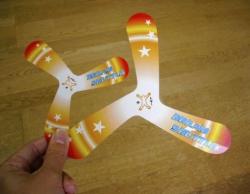Testing a boomerang in space might look and sound trivial, but it’s an exciting physics experiment that helps scientists to understand the dynamics of flight in microgravity. And now, one aspect of the “boomerang in space†question has finally been tested and answered. Japanese astronaut Takao Doi “threw a boomerang and saw it come back” during his free time on March 18 at the International Space Station, said a spokeswoman for the Japan Aerospace Exploration Agency. “I was very surprised and moved to see that it flew the same way it does on Earth,” the 53-year-old Doi was quoted as saying. This test was done inside a pressurized module of the ISS. But, one big question about boomerangs in space remains:
Will it work in the vacuum of space?
No, says boomerang expert and designer Gary Broadbent. The boomerang that was used in the experiment on board the ISS was a design of Broadbent’s called a “Roomerang,†a small, tri-blade boomerang intended for use indoors in a small area or outdoors in light winds. It travels 5 to 8 feet before returning to the thrower.
Broadbent told Universe Today that a boomerang would not work in the vacuum of space. “You need air molecules to generate the lift to make the boomerang turn,†Broadbent said.
But he also added that in the pressurized environment of the ISS, “microgravity has very little effect on the boomerang flight. The boomerang is so versatile, it can be tuned to fly in a perfect path back to the thrower, with gyroscopic precession and angular momentum over-compensating the lack of gravity.â€

Doi decided on boomerang tests after he received a request from Yasuhiro Togai, a world boomerang champion who helped Doi train to throw a boomerang correctly. Broadbent said that he has part of the preparations as well, and has been to Florida 3 times in the past month, working on the experiment with Doi.
The wings of a boomerang are set at a slight tilt and they have an airfoil design (rounded on one side and flat on the other, just like an airplane wing), which gives the wing lift.
The uneven force caused by the difference in speed between the three wings (two wings on a regular boomerang) applies a constant force which forces the boomerang to turn. So, just as if you lean in one direction while riding a bicycle, and the bike turns in that direction, the boomerang is constantly turning with force in one direction, so that it travels in a circle and comes back to its starting point.
Even though Broadbent says boomerangs wouldn’t work in a vacuum, it still would be fun to test it. The only problem of doing this experiment out in space is that the boomerang would just become another piece of potentially dangerous space junk in Earth orbit.
A videotape of the experiment performed during the STS-123 mission will likely be released in the near future.
Original News Source: Physorg.com and email interview with Gary Broadbent. For more information on Broadbent’s Boomerang’s see Gary’s website


I was wondering when these astronauts would finally try boomeranging, after all, they use gyroscopes which precess, as do tops, esp the ‘big Top'(earth).
The 3 main forces are: i) lift produced from airfoil of wing as it’s thrown precipitously forward at a near vertical angle. The horizontal release, sidearm as frisbees are thrown, will cause the ‘rang to climb & then crash (not far from where you’re standing)!
ii) the angle b/w the lead & trailing(dingle) arm as it spins causes the precession. You really have to work at the spin release, because it’s necessary to follow through, like a real good curveball pitcher. That last snap & imparted spin does the turning. Imagine pushing on a spinning top or spinning bicycle wheel. That force shunts 90degrees in spin dir, so the top reacts perpendicular to your push. The spinning bicycle wheel might be newton’s 2nd law @ inertia.
iii) After lift & precession spend their forces, you should be left w a hovering ‘helicopter-like’ blade fluttering overhead (or in a creek w my luck). Poke your hand through the virtual center of gravity hole, or safely sandwich it between your hands to bring it to rest.
That only explains 75-80% of it’s flight, as unfortunately science can’t handle boomerangs yet. To see how sensitive they are, you have to make your own. They can’t be mfg. From the Finnish hardwood, the arm angle, aerofoil design, embedded cerium weights, arm lengths, moisture, veneer…each will be a work in progress. You design each for specific flight characteristics, test & adjust, test & adjust… Some characteristic competitions: distance, doubles, repeats, max time aloft, pinwheels, speed, etc. Join a local Boomerang club near you, attend some competitions. The Aussies & Americans used to have an annual challenge meet.
Meanwhile…back at the shuttle, they should try the Aboriginal Boomerang. The Aborigineez hunt w a longer siccle-shaped boomerang, which needn’t return. They throw it side arm with hefty spin. Hear the aerofoil adds just enough lift to skirt the pampas, hovering a few feet above ground, for several hundred meters. The rapid spin imparts bone-shattering torque to the legs of hoofed ungulates, or marsupials. They should have flown an Aboriginal astronaut for this.
Boomerangs are not space junk. They got tens of thousands schrapnel flying around already! Boomerangs worst enemy’s the wind, that’s when we should all fly a kite,….about 200km up! Les
I wonder what would happen in space.
I mean in space, not only in microgravity with pressured air.
So we can pointlessly knock golf balls around in space, but we can’t test valid physics questions?
No, Boomerangs much like a curve ball follow the law of aerodynamics, which does not extend in to the vacuum of space
Ok, the boomerang is already paid for in launch expense. So superglue a transponder chip to its center, go out and toss it into space and track it as long as possible.
In the absence of particles (like our atmosphere) or gravity, once set in motion it will continue in motion, in a straight line. But every collision will have an effect.
Of course a boomerang will not work in a vacuum. Didn’t the questioner watch the Apollo 17 Falcon feather / hammer footage?
I’m surprised that such a question was put forward in this otherwise well-informed forum, and I am only a former Space Academy counselor.
Now HERE’S a worthy experiment: Partially inflate a balloon inside the ISS, then take it out through the airlock (where it will undoubtedly expand many times), then let it go in space! I’d be interested to see if its trajectory were straight and true or goofyfied. (OK, sure. you can tell that I’ve had two martinis on an empty stomach — BUT! Can you also tell that I also have the hiccups?)
I’m a bit surprised that the boomerang acted much the same as it does on Earth. Gravity on Earth balances the lift action created by the spinning airfoils, thus creating a level flight. I would have thought that in space, the lack of gravity would have made the lift of the spinning airfoils cause the boomerang to shoot straight up in the air, up to the “ceiling” in a vertical fashon because there’s no gravity to counteract the lift and hold things in level flight. I still don’t understand why it flew level in space.
Carl, the main force is precession ii. The dingle arm sees different air/fluid than leading arm. Depending upon arm angles, aerofoil, length, etc, the dingle sees turbulence to the leading arm’s laminar flow. This turning moment returns it promptly in a pinwheel(multi-blader) which are designed for short throws indoors (on stage). Other designs would provide more lift. In vacuum of space, however, aren’t many air molecules to provide this contrast in airflow b/w leading & dingle wings.
Yes, Only if the boomerang has solar sails on one wing.
So this is basic Bernoulli principles it sounds like. Is there more to it?
This has been the third time a boomerang has been thrown in space now.
Takao Doi just confirmed what french astronaut Jean Francois Cleroy found in 1997 (on MIR) and German Astronaut Ulf Meerbold found in 1992 (on Spacelab).
Good post, Carl J. You make an excellent point. I would think a boomerang thrown in micro-gravity and normal air pressures (around 14 psi) would spiral upwards until aerodynamic drag stopped its motion.
In the ISS it will develop lift perpendicular to the spin but it still have a forward motion due to the throw. It would eventually slow down in both directions as air resistance would cause drag in all vectors. Thrown in space it would act like a spinning gyroscope. It would follow the curvature of space while spinning until it ran into the Hubble and cracked the mirror.
of corse the boomerang will come back………. in 75 years or so after its passed round the sun…….. or am i thinking of haleys comet